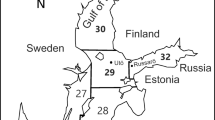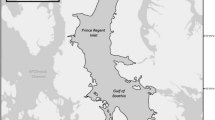Abstract
We analyzed a long-term data set of the body condition of Baltic gray seals (Halichoerus grypus) over time and investigated how average subcutaneous blubber thickness of different age groups of seals corresponds to environmental factors. Blubber thickness of pups declined until 2010. The decreasing weight of 5–6-year-old herring (Clupea harengus), the main prey fish for Baltic gray seals, explained well the decline. In the Gulf of Finland, the blubber thickness of pups declined also in recent years (2011–2015) with declining number of days with permanent ice cover. In other regions, the blubber thickness of pups increased during recent years with increasing weight of herring. The blubber thickness of sub-adults in Baltic Proper and that of hunted adult females in the Bothnian Bay also increased during recent years, and the weight of age 6+ or 7-year-old herring best explained the increase. The blubber thickness of all age groups of seals was thinnest in the Bothnian Bay where also herring weight was lowest. There was a negative correlation between blubber thickness of seals and herring catch size (an index of herring abundance) suggesting that herring quality, not the quantity, is important for the nutritional status of Baltic gray seals. Nutritional status of gray seals may thus reveal changes in the marine food web which affect herring quality. Marine food web, in turn, may be affected, e.g., by climate change. The warming climate also has an impact on ice cover and thus body condition of seal pups.




Similar content being viewed by others
References
Bäcklin BM, Moraeus C, Roos A, Eklöf E, Lind Y (2011) Health and age and sex distributions of Baltic grey seals (Halichoerus grypus) collected from bycatch and hunt in the Gulf of Bothnia. ICES J Mar Sci 68:183–188
Baker JR (1984) Mortality and morbidity in grey seal pups (Halichoerus grypus). Studies on its causes, effects of environment, the nature and sources of infectious agents and the immunological status of pups. J Zool 203:23-48
Bowen WD, Iverson SJ, McMillan JI, Boness DJ (2006) Reproductive performance in grey seals: age-related improvement and senescence in a capital breeder. J Anim Ecol 75:1340–1351
Bowen WD, Heyer CE, McMillan JI, Iverson SI (2015) Offspring size at weaning affects survival to recruitment and reproductive performance of primiparous gray seals. Ecol Evol 5:1412–1424
Boyd IL (1984) The relationship between body condition and the timing of implantation in pregnant Grey seals (Halichoerus grypus). J Zool 203:113–123
Boyd IL, Lockyer C, Marsh HD (1999) Reproduction in marine mammals. In: Reynolds JE, Rommel SA (eds) Biology of marine mammals. Smithsonian Institution Press, Washington
Burke KA, Gulland FMD, O’Hara TM (2008) Effects of climate change on arctic marine mammal health. Ecol Appl 18:S126–S134
Casini M, Cardinale M, Hjelm J (2006) Inter-annual variation in herring, Clupea harengus, and sprat, Sprattus sprattus, condition in the central Baltic Sea: what gives the tune? Oikos 112:638–650
Casini M, Lövgren J, Hjelm J, Cardinale M, Molinero JC, Kornilovs G (2008) Multi-level trophic cascades in a heavily exploited open marine ecosystem. Proc R Soc B Biol Sci 275:1793–1801
Casini M, Bartolino V, Molinero JC, Kornilovs G (2010) Linking fisheries, trophic interactions and climate: threshold dynamics drive herring Clupea harengus growth in the central Baltic Sea. Mar Ecol Prog Ser 413:241–252
Durbin J, Watson GS (1951) Testing for serial correlation in least squares regression, II. Biometrika 38:159–179
Gårdmark A, Östman Ö, Nielsen A, Lundström K, Karlsson O, Pönni J, Aho T (2012) Does predation by grey seals (Halichoerus grypus) affect Bothnian Sea herring stock estimates? ICES J Mar Sci 69:1448-1456
Hall AJ, McConnell BJ, Barker RJ (2001) Factors affecting first-year survival in grey seals and their implications for life history strategy. J Anim Ecol 70:138–149
Hall AJ, McConnell BJ, Barker RJ (2002) The effect of total immunoglobulin levels, mass and condition on the first-year survival of Grey seal pups. Funct Ecol 16:462–474
Hammill MO, Gosselin JF (1995) Grey seal (Halichoerus grypus) from the Northwest Atlantic: female reproductive rates, age at first birth, and age of maturity in males. Can J Fish Aquat Sci 52:2757–2761
Harding KC, Fujiwara M, Axberg Y, Härkönen T (2005) Mass-dependent energetics and survival in harbour seal pups. Funct Ecol 19:129–135
Harding KC, Bäcklin BM, Moraeus C, Kauhala K, Siebert U, Härkönen T (2015) Nutritional status of Baltic seals. HELCOM core indicator report. Online: http://www.helcom.fi/Core%20Indicators/Nutritional%20status%20of%20marine%20mammals_HELCOM%20core%20indicator%20report%202015_web%20version.pdf
Harwood LA, Smith TG, Melling H (2000) Variation in reproduction and body condition of the ringed seal (Phoca hispida) in western Prince Albert sound, NT, Canada, as assessed through a harvest-based sampling program. Arctic 53:422–431
HELCOM (2013) Climate change in the Baltic Sea area HELCOM thematic assessment in 2013. Baltic Sea environment proceedings no. 137. Helsinki Commission, Baltic Marine Environment Protection Commission. pp. 66
ICES (2016) Report of the Baltic fisheries assessment working group (WGBFAS), 12-19 April 2016, ICES HQ, Copenhagen, Denmark. ICES CM 2016/ACOM:11. 594 pp. Online: http://www.ices.dk/sites/pub/Publication%20Reports/Expert%20Group%20Report/acom/2016/WGBFAS/01%20WGBFAS%20Report%202016.pdf
ICES (2017) Report of the Baltic fisheries assessment working group (WGBFAS). 19–26 April, Copenhagen, Denmark. ICES CM 2017/ACOM:11. Pp. 787
Jüssi M, Härkönen T, Helle E, Jüssi I (2008) Decreasing ice coverage will reduce the breeding success of Baltic grey seal (Halichoerus grypus) females. Ambio 37:80–85
Kauhala K, Kunnasranta M, Valtonen M (2011) Hallien ravinto Suomen merialueella 2001–2007 – alustava selvitys [diet of grey seals in Finland in 2001–2007 – a preliminary study]. Suomen Riista 57:73–83 [In Finnish with English summary]
Kauhala K, Ahola MP, Isomursu M, Raitaniemi J (2016) The impact of food resources, reproductive rate and hunting pressure on the Baltic grey seal population in the Finnish sea area. Ann Zool Fenn 53:296–309
Keinänen M, Uddström A, Mikkonen J, Casini M, Pönni J, Myllylä T, Aro E, Vuorinen PJ (2012) The thiamine deficiency syndrome M74, a reproductive disorder of Atlantic salmon (Salmo Salar) feeding in the Baltic Sea, is related to the fat and thiamine content of prey fish. ICES J Mar Sci 69:516–528
Kjellqvist SA, Haug T, Øritsland (1995) Trends in age-composition, growth and reproductive parameters of Barents Sea harp seals, Phoca groenlandica. ICES J Mar Sci 52:197–208
Kuiken T, Bennett PM, Colin RA, Kirkwood JK, Baker JR, Lockyer CH, Walton MJ, Sheldrick MC (1994) PCBs, cause of death and body condition in harbor porpoises (Phocoena phocoena) from British waters. Aquat Toxicol 28:13–28
Lonergan M, Duck CD, Thompson D, Moss S, McConnell B (2011) British grey seal (Halichoerus grypus) abundance in 2008: an assessment based on aerial counts and satellite telemetry. ICES J Mar Sci 68:2201–2209
Lundström K, Hjerne O, Alexandersson K, Karlsson O (2007) Estimation of grey seal (Halichoerus grypus) diet composition in the Baltic Sea. Nammco Sci Publ 6:177–196
Lundström K, Hjerne O, Lunneryd SG, Karlsson O (2010) Understanding the diet composition of marine mammals: grey seals (Halichoerus grypus) in the Baltic Sea. ICES J Mar Sci 67:1230–1239
Mansfield AW (1991) Accuracy of age determination in the grey seal Halichoerus grypus of eastern Canada. Mar Mamm Sci 7:44–49
Östman Ö, Karlsson O, Pönni J, Kaljuste O, Aho T, Gårdmark A (2014) Relative contributions of evolutionary and ecological dynamics to body size and life-history changes of herring (Clupea harengus) in the Bothnian Sea. Evol Ecol Res 16:417–433
Pomeroy PP, Fedak MA, Rothery P, Anderson S (1999) Consequences of maternal size for reproductive expenditure and pupping success of grey seals at north Rona, Scotland. J Anim Ecol 68:235–253
Slotte A (1999) Differential utilization of energy during wintering and spawning migration in Norwegian spring-spawning herring. J Fish Biol 54:338–355
Stenman O (2009) Hallien kalaravinnosta Perämeren kevätjäillä [fish diet of grey seals in the Bothnian Bay in spring]. Suomen Kalastuslehti 3:15–17 [In Finnish]
Sundqvist L, Harkonen T, Svensson CJ, Harding KC (2012) Linking climate trends to population dynamics in the Baltic ringed seal: impacts of historical and future winter temperatures. Ambio 41:865–871
Vuorinen PJ, Parmanne R, Vartiainen T, Keinänen M, Kiviranta H, Kotovuori O, Halling F (2002) PCDD, PCDF, PCB and thiamine in Baltic herring (Clupea Harengus L.) and sprat [Sprattus Sprattus (L.)] as a background to the M74 syndrome of Baltic salmon (Salmo Salar L.) ICES J Mar Sci 59:480–496
Acknowledgements
We are grateful to J. Vainio from the Finnish Meteorological Institute for providing data of the ice conditions in the Baltic Sea. We wish to thank all hunters and fishermen who sent us samples of seals, and C. Moraeus and P. Timonen who helped us in the laboratory.
Author information
Authors and Affiliations
Corresponding author
Additional information
Communicated by: Cino Pertoldi
Appendix
Appendix
Rights and permissions
About this article
Cite this article
Kauhala, K., Bäcklin, BM., Raitaniemi, J. et al. The effect of prey quality and ice conditions on the nutritional status of Baltic gray seals of different age groups. Mamm Res 62, 351–362 (2017). https://doi.org/10.1007/s13364-017-0329-x
Received:
Accepted:
Published:
Issue Date:
DOI: https://doi.org/10.1007/s13364-017-0329-x




